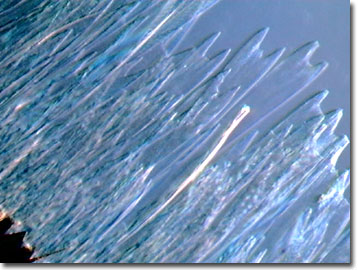Butterfly Wing Scale Digital Image Gallery
Spicebush Swallowtail Butterfly
Despite its common name, when given a choice the female spicebush swallowtail butterfly will most often choose sassafras as the host plant and food source for its larvae, even when spicebush is in close proximity. Adults gather nectar from a variety of sources including mimosa trees, Japanese honeysuckle, milkweed, lantana, azalea, and other ornamental plants. While on feeding forays, fertilized females will frequently visit food or host plants to lay a single egg on the underside of a leaf.

Spicebush swallowtail butterflies, also known as Papilio troilus, range throughout eastern North America and frequent a broad sweep of habitats, including deciduous forests, pine barrens, open fields, road right-of-ways, parks, and gardens. The adult spicebush swallowtail butterfly features a characteristic broad green-blue band and several submarginal spots on its upper hind wings, which are greener on male members of the species, and bluer on females. The butterflies are Batesian mimics of the toxic pipevine swallowtail butterfly, which provides the palatable species with some protection from predators.
The metamorphosis of spicebush swallowtails is a complex and colorful process. The greenish-white spicebush swallowtail eggs hatch into small green or brown caterpillars that feature cryptic markings resembling bird droppings during the first three instars. The nocturnal feeders spend much of the day hidden in their silken leaf furls. Mature caterpillars are large, green and feature two pairs of large, false eyespots, one set of which is solid orange and another that is a bright blue outlined in orange. Before pupating, the larvae turn a brilliant yellow. The chrysalides of spring and summer cohorts are a yellow-green and adult butterflies emerge in approximately nine to twelve days. Other cohorts from the late summer or early fall undergo winter diapause as reddish-brown pupae and appear as adults the following spring, ready to initiate the life cycle once again.
A favorite of butterfly conservatories, spicebush swallowtails are featured in many lepidopteran collections because of their large, showy wings and the availability of sufficient supplies of suitable larval food plants. Similar to other nectar-feeding and herbivorous insects, spicebush swallowtail butterflies and their larvae are susceptible to home and agricultural pesticide applications. However, due to the wide variety of habitats used by the spicebush swallowtail, its status is relatively secure, although it may be rare at the periphery of its range.
Contributing Authors
Cynthia D. Kelly, Shannon H. Neaves, Laurence D. Zuckerman, and Michael W. Davidson - National High Magnetic Field Laboratory, 1800 East Paul Dirac Dr., The Florida State University, Tallahassee, Florida, 32310.
BACK TO THE BUTTERFLY WING SCALE IMAGE GALLERY
BACK TO THE DIGITAL IMAGE GALLERIES
Questions or comments? Send us an email.
© 1995-2025 by Michael W. Davidson and The Florida State University. All Rights Reserved. No images, graphics, software, scripts, or applets may be reproduced or used in any manner without permission from the copyright holders. Use of this website means you agree to all of the Legal Terms and Conditions set forth by the owners.
This website is maintained by our
Graphics & Web Programming Team
in collaboration with Optical Microscopy at the
National High Magnetic Field Laboratory.
Last Modification Friday, Nov 13, 2015 at 01:19 PM
Access Count Since January 21, 2003: 8783
Visit the website of our partner in introductory microscopy education:
|
|
